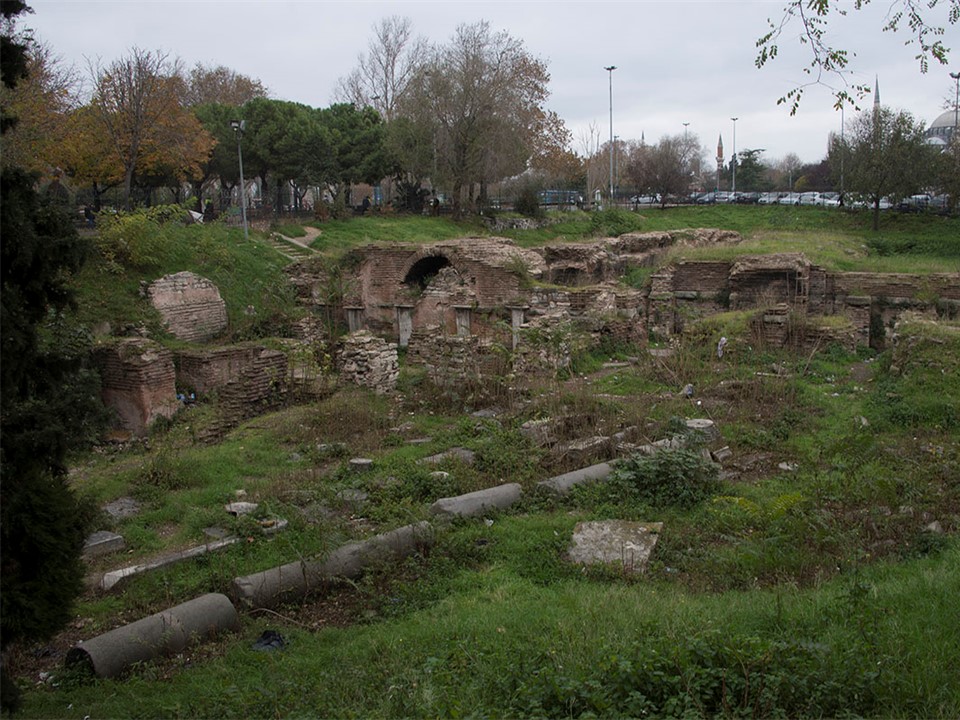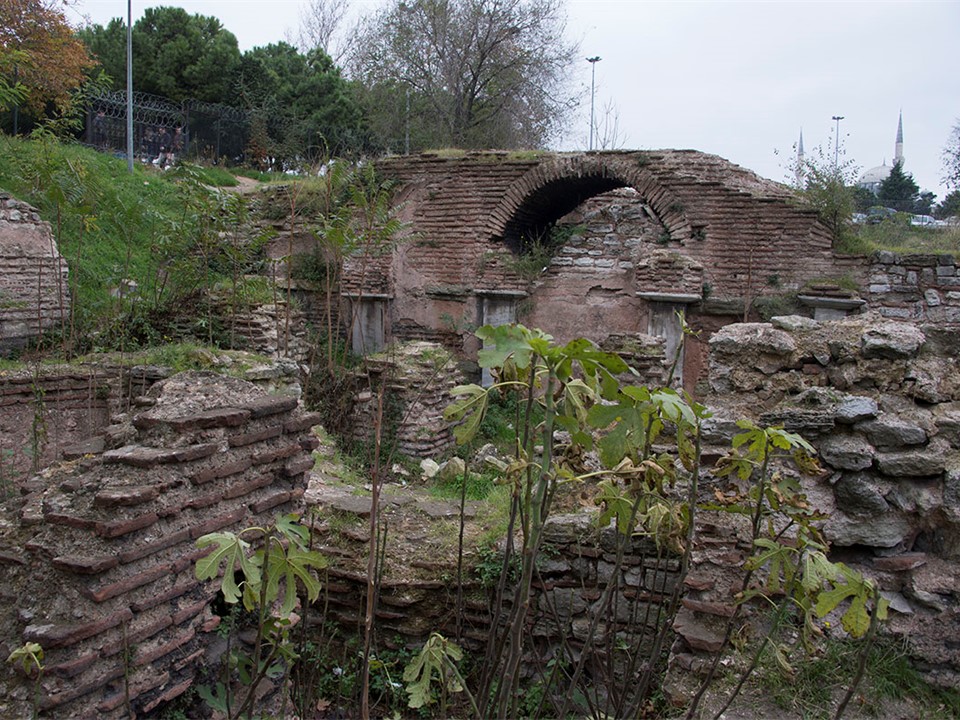
“The empress Eudocia, in her eagerness to honour God, was the first to build a temple to the divinely inspired Polyeuktos; but she did not make it like this or so large, not from any thrift or lack of resources—for what can a queen lack?—(5) but because she had a divine premonition that she would leave a family which would know how to provide a better embellishment. From this stock Juliana, bright light of blessed parents, sharing their royal blood in the fourth generation, did not cheat the hopes of that queen, who was mother of the finest children, (10) but raised this building from its small original to its present size and form, increasing the glory of her many-sceptred ancestors.” The Church of the Holy Martyr Polyeuktos has it all… a 6th-century magnificent building, in ruins today, with intricate decoration, a documented 76-line poem in Greek Anthologia (AP 1.10), stories of greed and looting, excavations in the 1960s, extensive Bibliography from around the world and currently, an Archaeological Site, frequently overlooked(?)…https://chs.harvard.edu/CHS/article/display/3263.mary-whitby-the-st-polyeuktos-epigram-ap-1-10-a-literary-perspective and https://topostext.org/work/532
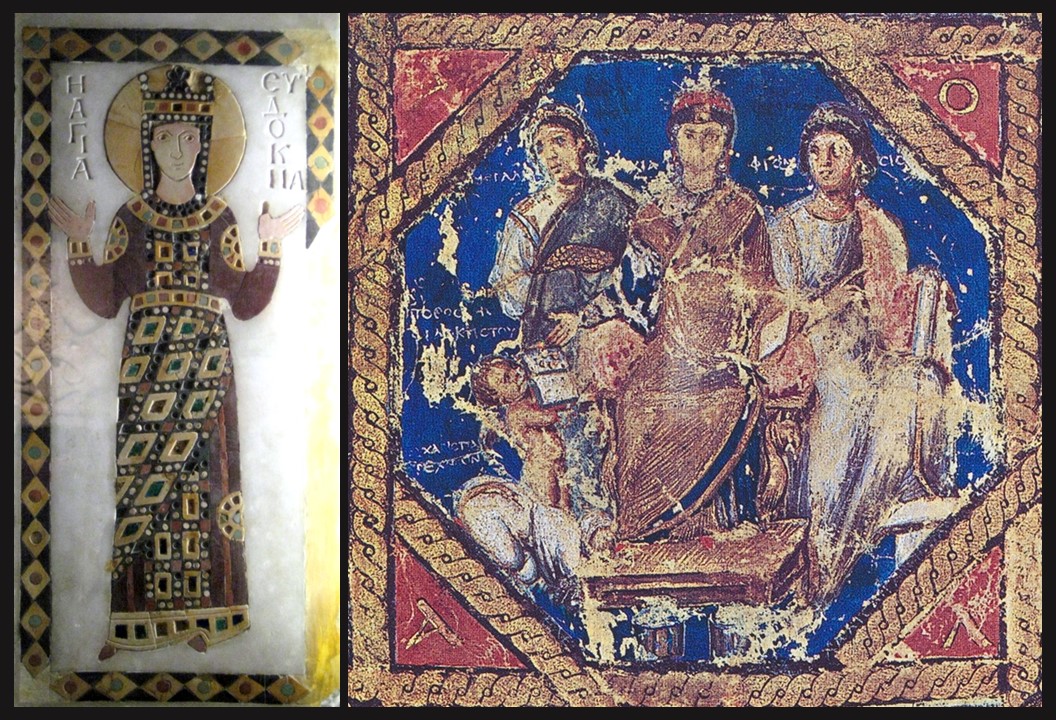
Portrait of Anicia Juliana flanked by Megalopsychia and Phronesis, Vienna Dioscurides, Folio 6v, about 515 AD, Byzantine Greek Illuminated Manuscript of De Materia Medica by Pedanius Dioscurides, vellum folios measure 37 by 30 cm, Österreichischen Nationalbibliothek, Vienna https://en.wikipedia.org/wiki/Anicia_Juliana#/media/File:Wiener_Dioskurides_6v_(portrait_detail).jpg
Empress Eudocia, according to the poem, was the first to build a small Church dedicated to Polyeuktos and Anicia Juliana, great-granddaughter of Eudocia, was the family member “which would know how to provide a better embellishment.” What an interesting family affair! To further elaborate on the early history and topography of the Church… it was constructed between 524 and 527, on the northern branch of Constantinople’s Mese, between the Forum Tauri and the Church of the Holy Apostles, near the Column of Marcian and the Aqueduct of Valens, in near proximity to the Palace of Anicia Juliana. https://www.thebyzantinelegacy.com/polyeuktos and http://constantinople.ehw.gr/Forms/filePage.aspx?lemmaId=11784
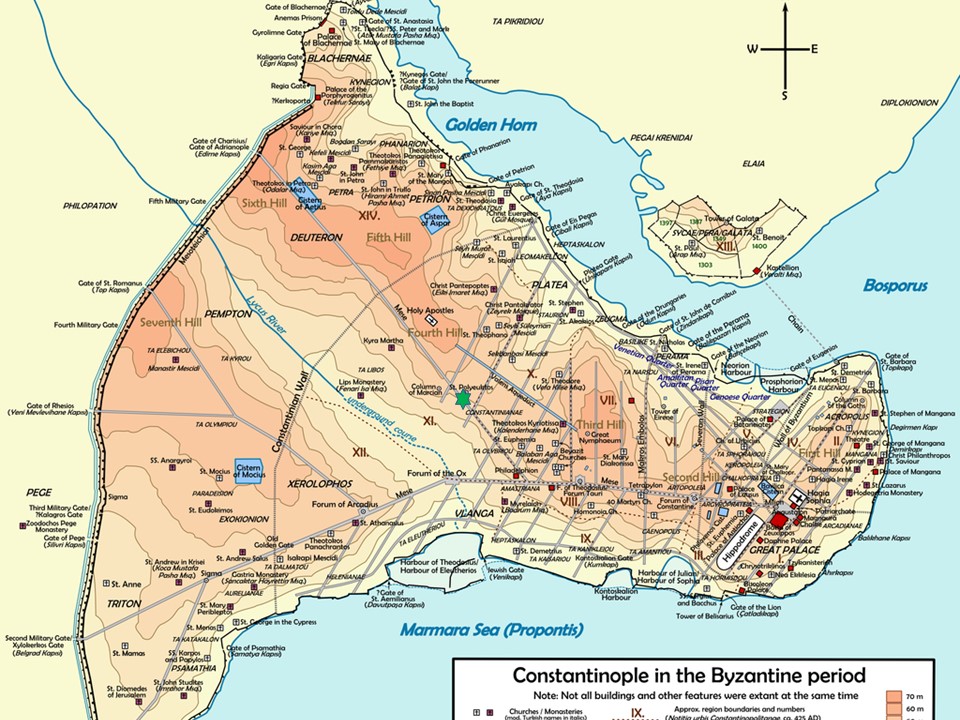
An accidental discovery in the 1960s, led to excavations in the area Saraçhane of modern Istanbul… which brought to light the foundation of a monumental church while inscriptions on several of the unearthed sculptural blocks, in fact, they were magnificently decorated extracts of the donor’s inscription, allowed Cyril Mango and Ihor Ševčenko to identify the archaeological discovery as the Church of the Holy Martyr Polyeuktos. Excavations on the site of the Church lasted six seasons (1964-69) and it was a joined effort between the Istanbul Archaeological Museum (represented by Nezih Fıratlı) and Dumbarton Oaks, Centre for Byzantine Studies of Harvard University, under the directorship of Professor Martin Harrison. Mango C., Ševčenko I., Remains of the church of St. Polyeuktos at Constantinople, Dumbarton Oaks Papers, 15, 1961 https://www.jstor.org/stable/i255238 and https://www.academia.edu/2122854/Martin_Harrisons_Excavations_in_Istanbul
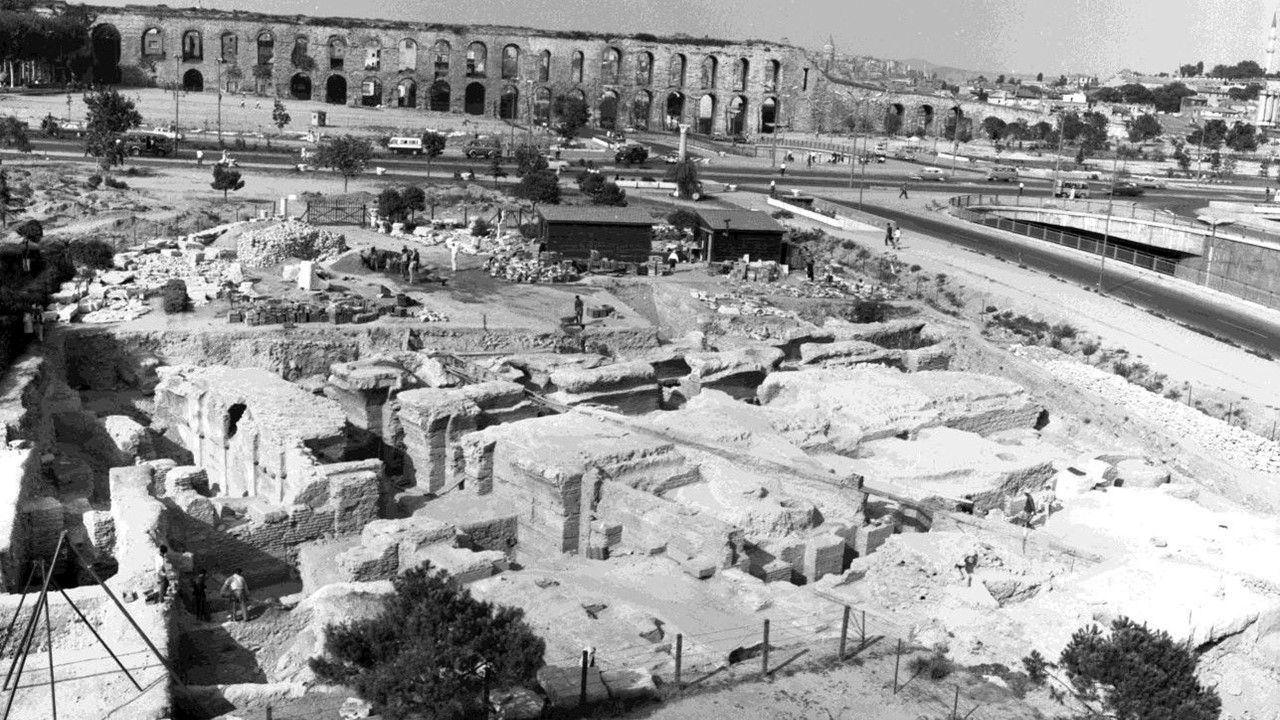
In the background of this photograph taken in 1968, of the Archaeological Excavation of the Church of the Holy Martyr Polyeuktos is the famous “Aqueduct of Valens”, a bridge that carried water for the Byzantine and Ottoman city… https://www.academia.edu/2122854/Martin_Harrisons_Excavations_in_Istanbul
At the time she commissioned the Church of St. Polyeuktos, Anicia Juliana, “sharing …royal blood in the fourth generation,” was the noblest and the wealthiest woman in the Empire. She lived in a magnificent palace in the area of the Church and “raised this building from its small original to its present size and form, increasing the glory of her many-sceptred ancestors.”At the entrance of the church, outside the narthex, archaeologists discovered five more inscribed plaques where we read… “What choir is sufficient to sing the contests of Juliana who, after Constantine, embellisher of his Rome, after the holy all-golden light of Theodosius, (45) and after royal descent from so many forebears, accomplished a work worthy of her family, and more than worthy / in a few years? She alone has overpowered time and surpassed the wisdom of the celebrated Solomon, raising a temple to receive God, the richly wrought and gracious splendour of which a great epoch cannot celebrate.”
There is no doubt Anicia Juliana was Emperor Justinian’s political and artistic, if I may add, adversary. Her dedicatory poem at the Church of the Holy Martyr Polyeuktos is a blunt challenge. Her Imperial lineage and wealth was a test to match for Justinian and his ambitions… According to Gregory of Tours, and well-recorded in Byzantine Legacy… “the Emperor Justinian requested the wealthy Juliana to make a contribution to the public treasury. She feigned to be willing to do so and invited the Emperor to visit her in her house after a given period of time during which she might be able to bring her treasure together. Meanwhile, she called in craftsmen, handed them all her gold and directed them to cast it into plaques which were to be affixed to the roof of Hagios Polyeuktos. After this had been done, Juliana invited the Emperor to come and, having taken him to the martyr’s church, pointed to its roof. My poverty is contained in this work. Do with it whatever you please…” she allegedly said, and thus avoided Justinian’s rapacity. What a story… https://www.thebyzantinelegacy.com/anicia-juliana and http://csla.history.ox.ac.uk/record.php?recid=E00655 and http://www.anastasiaashman.com/anastasiaashman/tag/Gregory+of+Tours
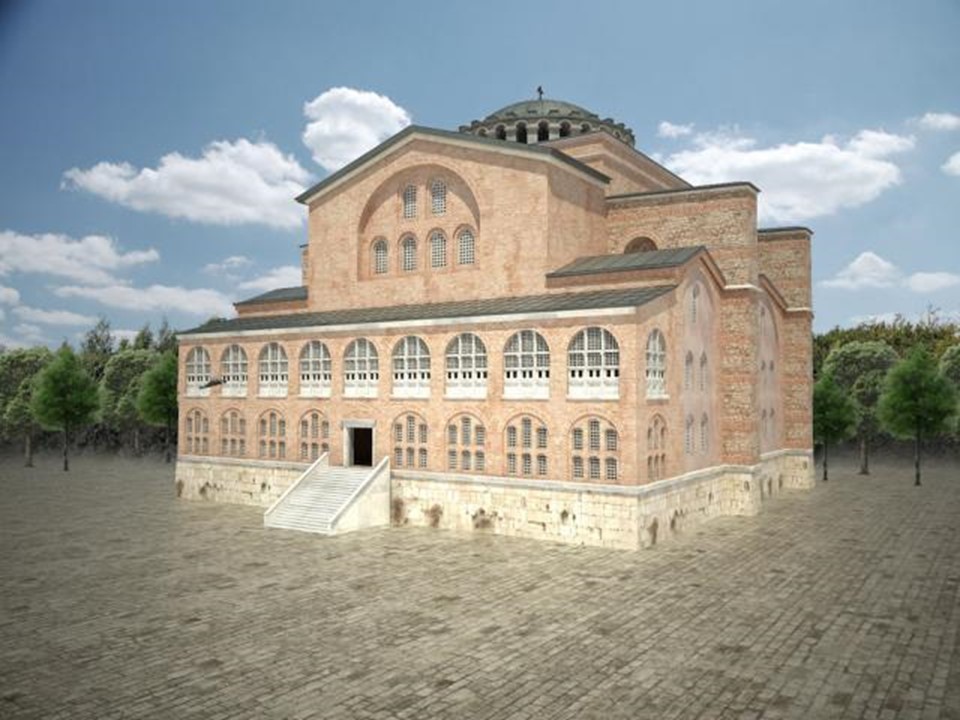
The Church of the Holy Martyr Polyeuktos was one of Constantinople’s most admired monuments for over five hundred years. “The church was certainly still in use in the 10th century, as it was one of the landmarks visited by the emperor during his Easter procession.” Then… we can only guess… the ornate Church of Anicia Juliana was gradually abandoned and valuable building materials were taken and used in the construction of other Constantinopolitan churches, such as the Pantokrator Monastery. In 1204 the Crusaders seized Constantinople and the Church, abandoned at the time, fell into ruins and many of its decorative architectural pieces were removed to Venice, Barcelona and Vienna.
After the Fall of Constantinople in 1453, “houses and a mosque were built in the now completely flattened space of St Polyeuktos’ church. This occupation of the location lasted until 1940 when the mosque was demolished. In 1960, during construction works in the area, some parts of the architecture of St Polyeuktos were unearthed” and a new period for the history of the Church started as a significant Archaeological Site “both due to the wealth and variety of the findings, and the architectural type of the church discovered.” http://constantinople.ehw.gr/Forms/filePage.aspx?lemmaId=11784
For a Student Activity, please… Check HERE!
Church of the Holy Martyr Polyeuktos, Part II, Architecture and Interior Decoration will follow in January 2021…
